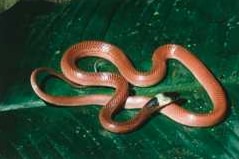I listened as the screams of macaws and Amazon parrots turned into the calls of hylid frogs. Daylight had passed over the Amazon, and the evening'
I listened as the screams of macaws and Amazon parrots turned into the calls of hylid frogs. Daylight had passed over the Amazon, and the evening's fauna was coming to life. My group of fellow travelers was devouring a meal of red-tailed catfish, heart of palm, yucca, and other native foods, but I had a hard time concentrating on my dinner. Instead, I daydreamed about what the night ahead might bring. We had been in Peru for a few days, but our luck in the field had been limited due to little rain. On this afternoon, the skies opened and intensely showered the area. The ground now squished beneath our feet and fresh water droplets fell from every tree we touched. Yes, our luck was soon to change after an evening of road cruising in the Amazon.
Read More
Expert Care for Amazon Tree Boas
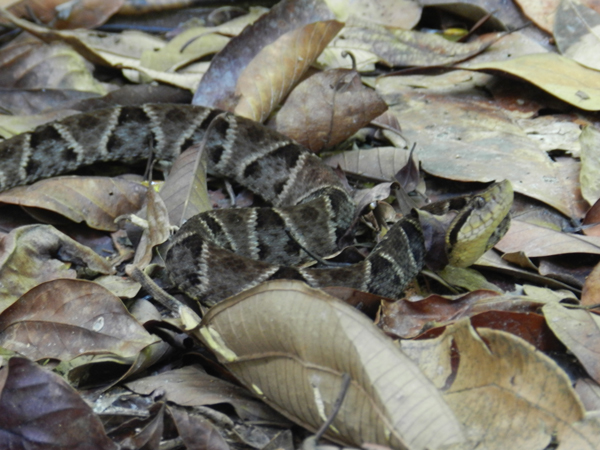
Feroze Omardeen/Wikipedia
Bothrops atrox
The Peruvian Amazon is host to a rich abundance of flora and fauna and is one of the world's most biologically diverse realms (Rodriguez and Duellman, 1993). During November of 1996, August of 1997 and January of 1998, I joined herpetologist Bill Lamar and several other wildlife enthusiasts for excursions to Iquitos, Peru. Needless to say, I was incredibly excited to have the opportunity to experience this natural wonderland. These excursions brought good times and unforgettable moments, many of which occurred while road cruising.
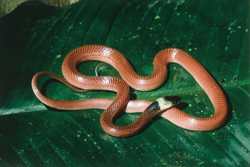
Matt Russell
This mussurana (Clelia clelia) looks very similar to the Amazon scarlet snake (Psuedoboa coronata). Both are found in the Iquitos, Peru, area.
Iquitos is located nearly 3,000 miles up the mighty Amazon River from the Atlantic Ocean and approximately 400 miles east of the Andes Mountains. It lies between the Nanay River to the north and the Itaya River to the south. This port city is the capital of the department of Loreto in northeastern Peru and rests nearly 400 feet (122 meters) above sea level and 3 degrees south of the equator.
Most biology-related travel in the Upper Amazon commences in Iquitos. There are nearly half a million people and multiple Amazonian tribes in the region. These tribes include the Boras, Cocamas, Yaguas and Ticunas, among others. Many of the citizens are of Spanish or other European descent, but some Americans reside there as well. This cultural diversity adds to the experience of nature travel in the area, and the people are quite friendly and willing to share endless experiences with "gringos." For example, I never imagined myself drinking masato, a traditional drink made of human saliva and yucca, but was urged to do so by locals. (You know what? I liked it!)
Travel on the streets of Iquitos is mostly by "motocar." These three-wheeled motorcycles are an enjoyable, but chaotic ride. I've witnessed a couple tip-overs during my time in Iquitos and have been involved in one accident while riding a motocar. Few people in this city own their own cars, but almost everyone has some form of water transportation.
The Amazon, along with its many tributaries, is the guiding force of life in Northern Peru. This 4,000-mile-long waterway begins in the Andes and terminates at the Atlantic Coast of Brazil. It possesses more than 1,000 tributaries, of which eight produce more water than North America's Mississippi River. Some of the main tributaries in the vicinity of Iquitos include the Rio Maraoun, Rio Ucayali, Rio Nanay, Rio Itaya, Rio Napo and the Rio Tigre. The Amazon River produces one-fifth of the world's water and courses through three countries.
The Amazon draws water from two sources: melting snow in the Andes Mountains and constant rainfall during the wet season. An average of 122 inches (310 centimeters) of rainfall occurs annually around Iquitos. During the wet season, the Amazon pours over large expanses of land, creating a habitat known as flooded forest. Local people refer to this forest type as bajial. When the dry season (June to October) arrives, the river is characterized by crisp banks, muddy beaches and long sand islands that disappear after the short arid spell. Both wet and dry seasons sport myriad plant and animal life, making the Amazon region a never-ending source of wonder.
Daytime temperatures throughout most of the year fall around 90 degrees Fahrenheit (32 degrees Celsius) and can dip 10 to 20 degrees Fahrenheit at night. Humidity is normally 100 percent through most of the year (Dixon and Soini, 1986). If heat and sweat bother you, this is definitely not the place to be.
The Iquitos region is home to a great diversity of habitats, although I will only mention a few here. One will find primary forest (old growth), secondary forest (new growth), flood plains, forest edge, terra-firma uplands, rivers, swamps, creeks, ponds, oxbow lakes and agricultural sites around Iquitos (Dixon and Soini, 1986). There are numerous intricate microhabitats among these general habitat types.
Iquitos' fish life is one of the most diverse assemblages in the world. Although a summary of Peru's avian fauna has not been completed, it is expected to surpass that of Colombia, which totals nearly 2,000 species. The local mammals include a dozen species of primates, two freshwater dolphin species, six wild cats, impressive semi-aquatic rodents such as capybaras and pacas, Brazilian tapirs and many more.
More than 360 species of reptiles and amphibians can be found throughout the Iquitos region (Lamar, 1997A; Lamar, B). Everything from casque-headed frogs (Hemiphractus sp.) to Amazon bushmasters (Lachesis muta) call the area home. Close to 100 species of snakes are known to occur in Iquitos, and that number continues to grow as new species are found.
During trips road-cruising the Iquitos area, my companions and I encountered several of the area's snake species. Until recently, there were no roads leaving Iquitos. All travel, including that between adjacent villages, took place by water or air. A paved track that allows travel to the neighboring town of Nauta is nearly complete. This 80-kilometer-long route passes through a number of different habitats that allow for absolutely incredible road cruising. Only 45 kilometers of this road is paved at present, but after dark it literally crawls with an assortment of snakes. Anacondas (Eunectes murinus), various coral snakes (Micrurus sp.), fer-de-lance (Bothrops atrox) and red-tailed boas (Boa constrictor) are just a few species that travel this road after dark.
Road Cruising
Road cruising to collect reptiles and amphibians is a favorite pastime for snake enthusiasts worldwide and has also been used as a means for research (Fitch, 1949; Campbell, 1953; Dodd, 1989). When our group was told it would be among the first to road cruise the Peruvian Amazon, a palpable anticipation could be felt. Although I prefer the forest, where all forms of life seemingly engulf you, the road to Nauta has consistently produced more snakes per night than a good evening elsewhere in the field.
Road cruising is best at night when temperatures drop, traffic ceases and snake species become active. Although some snakes in this area have diurnal habits, many choose to remain inactive until sunset.
Snakes can be found on or around roads for many reasons. Some animals search for road-killed prey or puddles of water, others bask on the road to soak up a day's worth of heat, and some simply move between two points. As seasoned snake enthusiasts know, the best time to find animals on the road seems to be during a new moon when there is less light. I have road-cruised on four separate occasions near Iquitos with three different groups of naturalists. Here's what it was like …
Snakes on the Road: The First Trip
After a hearty dinner, we set off by boat to a small port on the Rio Nanay known as Bellavista. As the small vessel sped away from our lodge on the Rio Momun, we all began to chat about what the night ahead might bring. A wish list seemed to be brewing in all of our minds. A medium-sized van picked us up at the port and took us across town to Iquitos and the Nauta road. Everyone boarded the vehicle with cameras and flashlights in hand anxiously awaiting the night ahead. A few of us carried gear (tongs and snake hooks) to facilitate the safe and easy restraint of venomous species. The best sets of eyes would take the front while the remaining individuals spot-lighted from the rear of the van.
As we rushed through the narrow roads of Iquitos, the bustle of the evening's nightlife could be heard. Music blared from the latino discotheques and motocars shot past us with riders anxious to get to the parties. It seemed odd that in just moments we would be away from this amusing chaos and searching for rare or elusive snakes.
Leaving the sounds of the city's nightlife in our wake, we began our excursion. The noise of nightclubs and traffic was replaced by that of calling frogs from trees to the side of the road. Our van splashed through puddles of water left over from an afternoon rain shower. Everyone in the vehicle became increasingly anxious and a few placed friendly bets on what our first catch might be. However, no live snakes crossed our path on the first run. Some people became skeptical, but one of the golden rules to road cruising is patience. This 45-kilometer-long slab of asphalt can appear lifeless one minute, but be littered with snakes the next!
The return trip proved more prolific. Our doubts were left behind when Bill Lamar motioned our driver to stop for an absolutely beautiful boa constrictor (Boa constrictor) crossing the road. Everyone immediately rushed from the van like excited children to get a glimpse of our first catch. Boa constrictor is a common snake in the Iquitos region and up until the early 1970s was shipped out of the area with frequency for the pet and skin trade. Other boids known here include blazing orange Brazilian rainbow boas (Epicrates cenchria), green anacondas (Eunectes murinus), Amazon tree boas (Corallus hortulanus) and emerald tree boas (Corallus caninus) (Dixon and Soini, 1986). With our adrenaline pumping and our faith regained, we boarded the van after photographing and releasing our prize. This was the first wild experience with a boa constrictor for some, and several people exhausted an entire night's worth of film on that one snake!
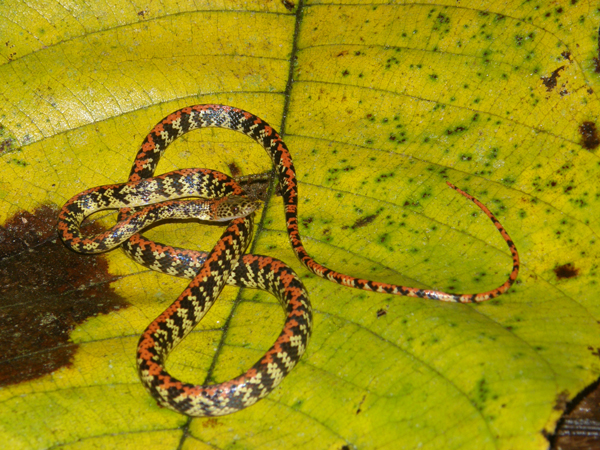
Siphlophus cervinus
Siphlophis cervinus occurs from Panama and Trinidad south to Bolivia and is known to stalk lizard prey at night from trees and shrubs.
At this point I got a good feeling about the remainder of the night. It was not long after our boa that we witnessed the first colubrid racing across the pavement. To my surprise, it was a relatively obscure species that we had caught in primary forest two nights earlier. Most of my companions were unfamiliar with liana snakes (Siphlophis cervinus) until this trip, but all quickly appreciated its striking red, black and yellow coloration. This denizen of tropical forests is rarely seen by humans, so our seeing one was a real treat. Siphlophis cervinus occurs from Panama and Trinidad south to Bolivia and is known to stalk lizard prey at night from trees and shrubs (Duellman, 1978; Jorge da Silva, 1993, Lamar, 1997A, 1997C). There are five species known in the genus Siphlophis, and four are exclusive to South America.
The calls of frogs from the trees above were muted by the click of cameras and the blare of our flashes. Road cruising in the Amazon typically presents one photo opportunity after another. After we stowed our cameras, our group fired questions back and forth about our most recent catch.
It was not long, however, before we were running across the pavement again for a beautiful snake that appeared to be coated in cherry red paint. Could it be a mussurana (Clelia clelia) or perhaps an Amazon scarlet snake (Pseudoboa coronata)? Both species are practically identical as juveniles and are only distinguishable by differences in their subcaudal scales. Other similarities include primarily terrestrial behavior, possession of venom conducting fangs in the rear of the mouth, and both feed on other reptiles. Clelia clelia, however, becomes shiny black as an adult and reaches lengths up to 8 feet (approximately 2.5 meters), but P. coronata retains its more flashy colors into adulthood and remains smaller, approximately 3 feet (1 meter). The bright colors exhibited by both species are probably a form of aposematic coloration to deter predators. After a quick examination, our catch proved to be P. coronata.
The night could have ended there with everyone returning to the lodge pleased, but one more surprise was in store for us. A large female fer-de-lance (Bothrops atrox) wound across the road in front of the van shortly before we reached the finish line. Local people refer to this species as "jergun" or "cascabel." The latter name, which is normally assigned to rattlesnakes, derives from the fact that juvenile B. atrox possess yellow tails for luring prey. This pit viper is no stranger to any habitat within the Iquitos region and adapts easily to areas of human disturbance (Dixon and Soini, 1986). On one occasion, I stumbled across a small B. atrox, on the way to the shower. Fortunately, I managed to see the beast before stepping on him. The occurrence of this species among human habitation coupled with its venom make it the most dangerous snake in the Amazon. Juvenile B. atrox feed primarily on frogs and tend to frequent low hanging vegetation and shrubs more often than adults. This species is widespread in South America, living in all countries but Chile, Argentina, Paraguay and Uruguay (Campbell and Lamar, 1989).
After firing off the last of my film and easing this large specimen to the side of the road, we were ready for the return trip to the lodge. The following day we departed our tropical paradise with long faces. However, I knew before boarding the plane that a return trip was in my near future.
On The Road Again: Trip Two
I found myself back on a plane bound for Iquitos in August of 1997. This would be my first trip to the Upper Amazon during the dry season, and I was anxious to see the effects of what little rain the area had received. I was not sure whether road cruising would be as productive during the dry season, but time would tell. Once again, a group of eager reptile enthusiasts accompanied me. While en route, the group pondered over what the week ahead might hold. For most, it would be their first trip. One thing was certain: We were all determined to see and photograph snakes.
After a few nights of hiking through lush but fairly dry tropical forests in pursuit of the area's herpetofauna and invertebrates, we decided to take to the road. The ground crunched beneath our feet during these evenings, and the sky had only opened once to rain since our arrival. What would this mean for snakes on the road?
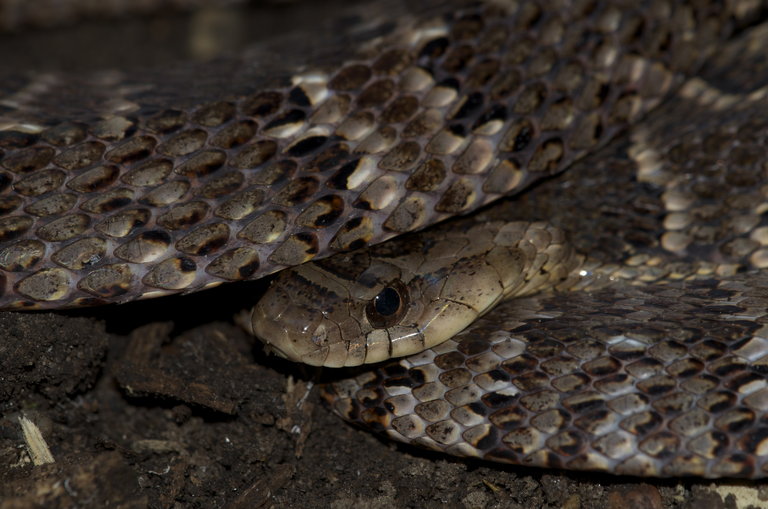
"Xenodon rabdocephalus. Photo by Ruth Percino Daniel/Wikimedia.org
The false viper (Xenodon rabdocephalus), look strikingly similar to Bothrops atrox.
We commissioned a van and another night of road cruising began. It was not long after we hit the pavement that an Amazon scarlet snake (Pseudoboa coronata) crossed our path. For most members of the group, this species was new and sparked lots of curiosity, but I was anxious to see something different. My wish was granted when we stopped not far up the road for a beautifully tri-colored snake that appeared to be a false coral. Although this animal seemed alive from our view in the van, it turned out to be a freshly road-killed specimen of the wedge-tailed earth snake (Atractus latifrons). This coral snake mimic lives in most terrestrial habitats throughout the Upper Amazon and feeds primarily on earthworms.
Many species of colubrids in the Neotropics mimic coral snakes (Micrurus sp.) via their similar morphology, while others, such as the false viper (Xenodon rabdocephalus), look strikingly similar to Bothrops atrox. Although many harmless and some mildly toxic colubrids strongly resemble venomous coral snakes, very few have identical banding. However, mistakes in identifying these snakes can be made easily by the unpracticed eye and have led to nasty bites.
Earlier in the trip, we discovered two additional species that mimic coral snakes. They included the black-headed calico snake (Oxyrhopus melanogenys) and the banded calico snake (O. petola digitalis). These terrestrial serpents stalk various lizard species at night. Both occur in primary and secondary forests within the Iquitos region (Dixon and Soini, 1986; Duellman, 1978).
Like elsewhere, people in Iquitos and throughout most of Latin America have little tolerance for snakes, and believe most are deadly and deserve to be killed. It would not be uncommon for vehicles to go out of their way to run snakes over on the road, especially those that mock coral snakes. As a snake enthusiast, I feel it is wise to educate locals about the importance these animals hold within their ecosystem. On several occasions, I have tried to dispel myths and share facts, but this tends to be much easier said than done.
Later that evening we stopped to stretch our legs and comb the side of the road by a small stream. Several tree frogs could be heard, but no live snakes turned up. We did, however, make an interesting find back on the road when we scooped a freshly killed vine snake (Oxybelis aeneus) from the ground for a closer look. This widespread species occurs from southern Arizona through Mexico and Central America, and as far south as Brazil and central Bolivia. Although O. aeneus can be found on the ground, they prefer to remain in the trees where they stalk lizards. The species name, aeneus, is latin for bronze or copper, much like this snake's coloration (Lee, 1996).
The vine snake would be the final catch for the evening. Two nights later, our last night in Iquitos, we returned to the road. Little did I know that this night would produce one of the most fascinating taxon I would see in the area.
Shortly after beginning our trek, a large multi-colored snake danced across the road. This South American coral snake (Micrurus lemniscatus helleri) would be the grand finale, but to me it was worth the entire trip. There are eight species of Micrurus that are confirmed to occur within this area (Lamar, 1997A). Micrurus l. helleri is one of four subspecies in the M. lemniscatus group and occurs in Peru, Ecuador, Colombia, Bolivia, Venezuela and Brazil. The morphology of this species is said to be quite variable, but M. l. helleri is very difficult to distinguish from the nominate race, Micrurus l. lemniscatus (Campbell and Lamar, 1989). It is a fairly large and slender Micrurus that can obtain lengths up to 1.4 meters (4.5 feet).
We collected this gem from the road to allow for staged photographs. The following morning, I awoke several hours early. Our plane would depart soon, but I wanted to aim my camera again at our prize from the previous night. Shortly after capturing the essence of this coral snake on film, the group faced reality and returned to Miami.
During the trip to the Unites States I pondered about how my excursions to the Upper Amazon were beginning to grow on me. I was becoming more and more passionate about all that came with traveling to the tropics. The spectacular flora and fauna, the culture and all around good times convinced me that my voyages to this realm would become more frequent.
The Final Run: Trip Three
On the last night of my trip in January of 1998, I was again able to cruise the road to Nauta. However, time was limited due to a big party in town, so we only made one slow run. (Sorry, but the party was really important!)
In just an hour's span we managed to capture three additional species I had yet to see on pavement. An ornate thirst snake (Dipsas catesbyi) was sighted first. This common colubrid is typically found on trees and shrubs in primary and thick secondary forest, even within Iquitos (Dixon and Soini, 1986).
The genus Dipsas gained its name from a serpent in Greek mythology whose bite was said to cause "thirst" in its victims. However, Dipsas sp. are harmless snakes and are not known to bite. This brown, black and white species has big, bulging eyes for easy navigation at night. Members of this group feed exclusively on a diet of snails and slugs.
Ten kilometers passed with little luck. Soon, however, I caught a glimpse of what appeared to be a South American water snake (Helicops angulatus) on the side of the road. These animals are typically found in shallow streams or small pools where they ambush frogs, tadpoles and fish. Their eyes are situated high on their heads, an adaptation for life in the water. These rough-scaled snakes will depress their entire body and flatten their neck while biting in defense (Duellman, 1978). Several H. angulatus were observed in the field on this trip, but the one on the road was a unique gift.
Although my mind was still geared toward road cruising at this point, visions of the Latin American discotheque began to dance in my head. Fewer snake thoughts were crossing my mind, and dancing and partying became a more appealing option. We had already encountered two incredible snakes, so it would take something major to lift me from the lure of the Iquitos city nightlife.
What luck! I was abruptly snapped from my thoughts when our guide shouted, "naca-naca!" In Peru, this could mean only one thing: coral snake! Incredibly recharged, I jumped from the van to the road to discover an aquatic coral snake (Micrurus surinamensis) retreating to the side of the road. My guide quickly handed me a hook to manipulate this relatively large specimen to the center of the road. It was there that the animal began flattening its body and displaying its tail, which is typical defensive behavior for most coral snakes.
Micrurus surinamensis is one of the largest and heaviest of the corals, attaining lengths of over 1.5 meters (4.5 feet). It occurs throughout much of northern South America and is usually encountered in or near water. Like Helicops, the eyes and nostrils of M. surinamensis are situated high on the head for an easier life in the water (Campbell and Lamar, 1989). Knife fish and synbranchid eels comprise the primary diet for this species.
Final Thoughts
Finding snakes on a paved road seemed almost out of place. Although many good times were shared in the forest, some of my best moments of each trip occurred on the route to Nauta. We found 13 species of snakes with little effort on the 45-kilometer stretch, and also observed several frogs and toads. As a matter of fact, both Phyllomedusa tarsius and P. tomopterna have been found on or around this road!
As each trip came to an end, I immediately began conjuring up images of what my next voyage would be like. What creatures would the next search reveal? Would I find new taxa that I had not yet seen? Every trip to the tropics seemed to pose more and more questions. Oh well, these are all matters to be discussed in another story. City life called, and it was time to party!
References
Campbell, H. 1953. Observations on snakes DOR in New Mexico. Herpetologica. 9:157-160.
Campbell, J. A., and W. W. Lamar. 1989. The Venomous Reptiles of Latin America. Cornell University Press, Ithaca. 425pp.
Dixon, J., and P. Soini. 1986. The Reptiles of the Upper Amazon Basin, Iquitos Region, Peru. Milwaukee Public Museum, Milwaukee. 154pp.
Dodd, C.K. 1989. Reptiles on highways in north-central Alabama, USA. Journal of Herpetology. 23(2)197-200.
Duellman, W.E. 1978. The Biology of an Equatorial Herpetofauna in Amazonian Ecuador. Univ. Kans.Mus. Nat. Hist. Misc. Publ. 65. 352pp.
Fitch, H.S. 1949. Road counts on snakes in western Louisiana. Herpetologica. 5:87-90.
Jorge da Silva, N. 1993. The snakes from Samuel Hydroelectric Power Plant and vicinity, Rondônia, Brazil. Herpetological Natural History. 1(1)37-86.
Lamar, W. W. 1997A. Checklist and common names of the reptiles of the Peruvian lower Amazon. Herpetological Natural History. 5(1) 73-76.
Lamar, W. W. 1997B. Checklist and common names of the amphibians of the Peruvian lower Amazon. Rev. de Biol. Tropical. In Press.
Lamar, W. W. 1997C. The World's Most Spectacular Reptiles and Amphibians. World Publications, Tampa, Florida. 208pp.
Lee, J.C. 1996. The Amphibians and Reptiles of the Yucatan Peninsula. Cornell University Press, Ithaca. 500pp.
Rodriguez, L., and W. E. Duellman. 1994. Guide to the Frogs of the Iquitos Region, Amazonian Peru. University of Kansas Natural History Museum (special publ. no. 22), Lawrence. 106pp.

